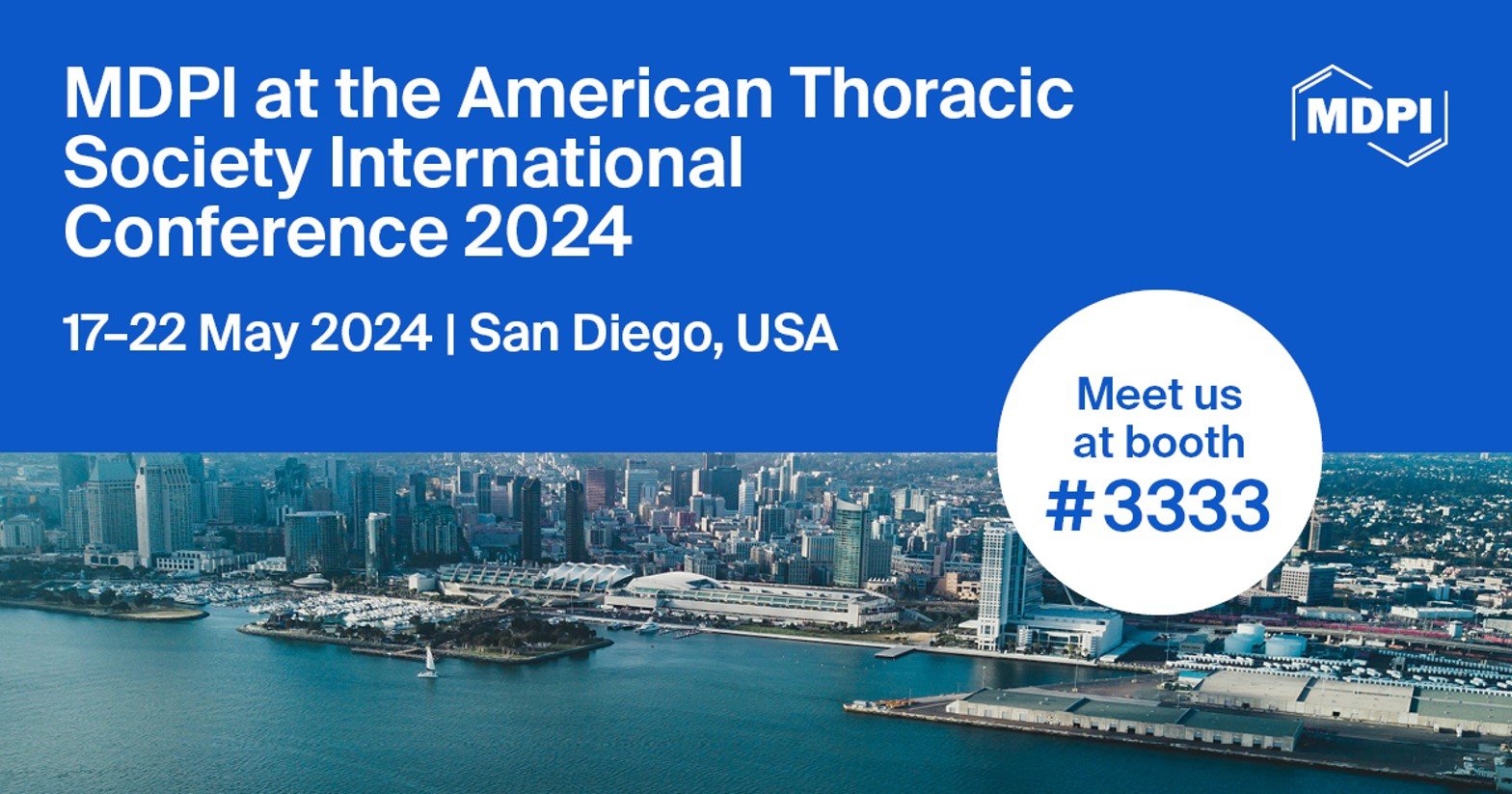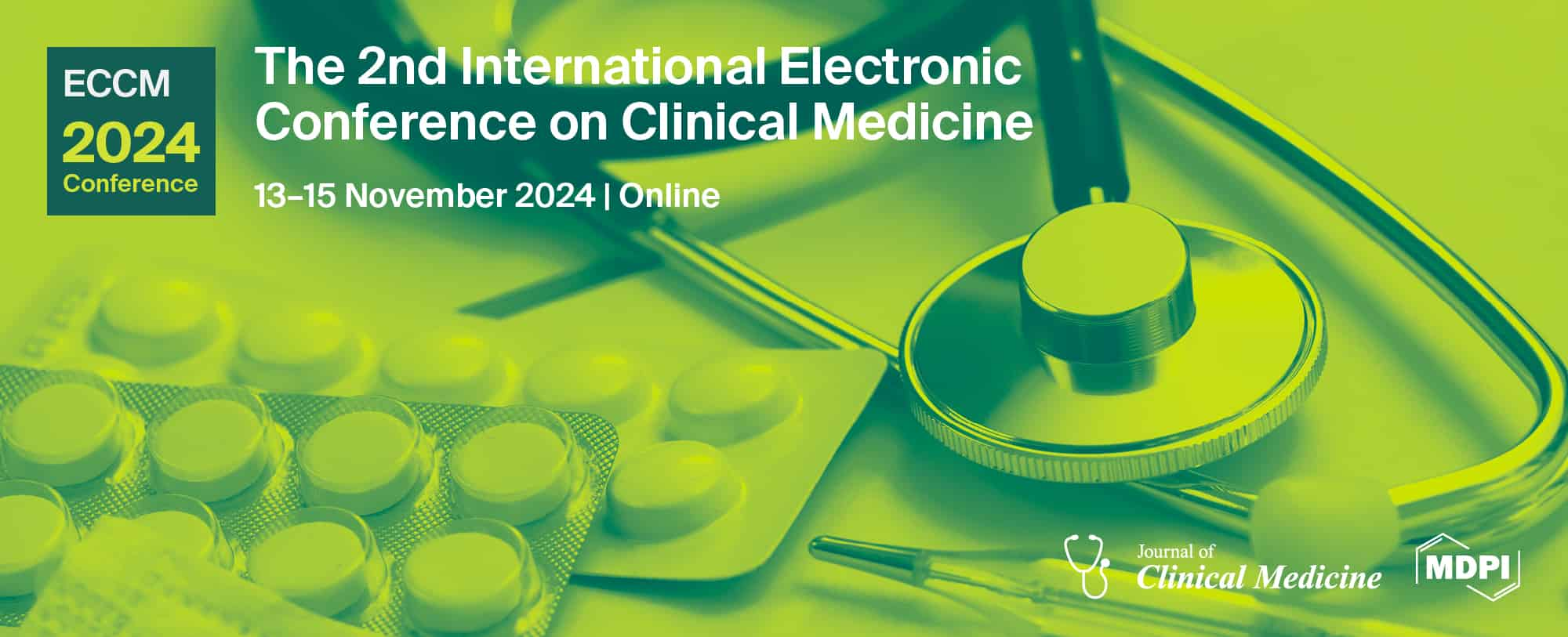-
 Neuropsychological Consequences of Massive Trauma: Implications and Clinical Interventions
Neuropsychological Consequences of Massive Trauma: Implications and Clinical Interventions -
 Impact of GLP-1 Agonists on Male Reproductive Health—A Narrative Review
Impact of GLP-1 Agonists on Male Reproductive Health—A Narrative Review -
 Acupuncture for Japanese Katakori (Chronic Neck Pain): A Randomized Placebo-Controlled Double-Blind Study
Acupuncture for Japanese Katakori (Chronic Neck Pain): A Randomized Placebo-Controlled Double-Blind Study -
 Giant Cell Arteritis after COVID-19 Vaccination with Long-Term Follow-Up: A Case Report and Review of the Literature
Giant Cell Arteritis after COVID-19 Vaccination with Long-Term Follow-Up: A Case Report and Review of the Literature -
 Worsening Symptoms Is Associated with Larger Cerebral Blood Flow Abnormalities during Tilt-Testing in Myalgic Encephalomyelitis/Chronic Fatigue Syndrome (ME/CFS)
Worsening Symptoms Is Associated with Larger Cerebral Blood Flow Abnormalities during Tilt-Testing in Myalgic Encephalomyelitis/Chronic Fatigue Syndrome (ME/CFS)
Journal Description
Medicina
Medicina
is an international, peer-reviewed, open access journal that covers all problems related to medicine. The journal is owned by the Lithuanian University of Health Sciences (LUHS) and is published monthly online by MDPI. Partner Societies are the Lithuanian Medical Association, Vilnius University, Rīga Stradiņš University, the University of Latvia, and the University of Tartu.
- Open Access— free for readers, with article processing charges (APC) paid by authors or their institutions.
- High Visibility: indexed within Scopus, SCIE (Web of Science), PubMed, MEDLINE, PMC, and other databases.
- Journal Rank: CiteScore - Q2 (General Medicine)
- Rapid Publication: manuscripts are peer-reviewed and a first decision is provided to authors approximately 19.6 days after submission; acceptance to publication is undertaken in 2.5 days (median values for papers published in this journal in the second half of 2023).
- Recognition of Reviewers: reviewers who provide timely, thorough peer-review reports receive vouchers entitling them to a discount on the APC of their next publication in any MDPI journal, in appreciation of the work done.
Impact Factor:
2.6 (2022);
5-Year Impact Factor:
2.9 (2022)
Latest Articles
Network Structure of Depressive Symptomatology in Elderly with Cognitive Impairment
Medicina 2024, 60(5), 687; https://0-doi-org.brum.beds.ac.uk/10.3390/medicina60050687 - 23 Apr 2024
Abstract
Objective and objectives: Patients with cognitive disorders such as Alzheimer’s disease (AD) and mild cognitive impairment (MCI) frequently exhibit depressive symptoms. Depressive symptoms can be evaluated with various measures and questionnaires. The geriatric depression scale (GDS) is a scale that can be
[...] Read more.
Objective and objectives: Patients with cognitive disorders such as Alzheimer’s disease (AD) and mild cognitive impairment (MCI) frequently exhibit depressive symptoms. Depressive symptoms can be evaluated with various measures and questionnaires. The geriatric depression scale (GDS) is a scale that can be used to measure symptoms in geriatric age. Many questionnaires sum up symptom scales. However, core symptoms of depression in these patients and connections between these symptoms have not been fully explored yet. Thus, the objectives of this study were (1) to determine core symptoms of two cognitive disorders, Alzheimer’s disease and mild cognitive impairment, and (2) to investigate the network structure of depressive symptomatology in individuals with cognitive impairment in comparison with those with Alzheimer’s disease. Materials and Methods: This study encompassed 5354 patients with cognitive impairments such as Alzheimer’s disease (n = 1889) and mild cognitive impairment (n = 3464). The geriatric depression scale, a self-administered questionnaire, was employed to assess depressive symptomatology. Using exploratory graph analysis (EGA), a network analysis was conducted, and the network structure was evaluated through regularized partial correlation models. To determine the centrality of depressive symptoms within each cohort, network parameters such as strength, betweenness, and closeness were examined. Additionally, to explore differences in the network structure between Alzheimer’s disease and mild cognitive impairment groups, a network comparison test was performed. Results: In the analysis of centrality indices, “worthlessness” was identified as the most central symptom in the geriatric depression scale among patients with Alzheimer’s disease, whereas “emptiness” was found to be the most central symptom in patients with mild cognitive impairment. Despite these differences in central symptoms, the comparative analysis showed no statistical difference in the overall network structure between Alzheimer’s disease and mild cognitive impairment groups. Conclusions: Findings of this study could contribute to a better understanding of the manifestation of depressive symptoms in patients with cognitive impairment. These results are expected to aid in identifying and prioritizing core symptoms in these patients. Further research should be conducted to explore potential interventions tailored to these core symptoms in patients with Alzheimer’s disease and mild cognitive impairment. Establishing core symptoms in those groups might have clinical importance in that appropriate treatment for neuropsychiatric symptoms in patients with cognitive impairment could help preclude progression to further impairment.
Full article
(This article belongs to the Section Psychiatry)
Open AccessSystematic Review
Enhancing Chronic Non-Cancer Pain Management: A Systematic Review of Mindfulness Therapies and Guided Imagery Interventions
by
Beatriz Manarte Pinto, Isaura Tavares and Daniel Humberto Pozza
Medicina 2024, 60(5), 686; https://0-doi-org.brum.beds.ac.uk/10.3390/medicina60050686 - 23 Apr 2024
Abstract
Background and Objectives: There has been an increasing interest in the use of non-pharmacological approaches for the multidimensional treatment of chronic pain. The aim of this systematic review was to assess the effectiveness of mindfulness-based therapies and Guided Imagery (GI) interventions in
[...] Read more.
Background and Objectives: There has been an increasing interest in the use of non-pharmacological approaches for the multidimensional treatment of chronic pain. The aim of this systematic review was to assess the effectiveness of mindfulness-based therapies and Guided Imagery (GI) interventions in managing chronic non-cancer pain and related outcomes. Materials and Methods: Searching three electronic databases (Web of Science, PubMed, and Scopus) and following the PRISMA guidelines, a systematic review was performed on Randomized Controlled Trials (RCTs) and pilot RCTs investigating mindfulness or GI interventions in adult patients with chronic non-cancer pain. The Cochrane Risk of Bias Tool was utilized to assess the quality of the evidence, with outcomes encompassing pain intensity, opioid consumption, and non-sensorial dimensions of pain. Results: Twenty-six trials met the inclusion criteria, with most of them exhibiting a moderate to high risk of bias. A wide diversity of chronic pain types were under analysis. Amongst the mindfulness interventions, and besides the classical programs, Mindfulness-Oriented Recovery Enhancement (MORE) emerges as an approach that improves interoception. Six trials demonstrated that mindfulness techniques resulted in a significant reduction in pain intensity, and three trials also reported significant outcomes with GI. Evidence supports a significant improvement in non-sensory dimensions of pain in ten trials using mindfulness and in two trials involving GI. Significant effects on opioid consumption were reported in four mindfulness-based trials, whereas one study involving GI found a small effect with that variable. Conclusions: This study supports the evidence of benefits of both mindfulness techniques and GI interventions in the management of chronic non-cancer pain. Regarding the various mindfulness interventions, a specific emphasis on the positive results of MORE should be highlighted. Future studies should focus on specific pain types, explore different durations of the mindfulness and GI interventions, and evaluate emotion-related outcomes.
Full article
(This article belongs to the Section Psychiatry)
►▼
Show Figures
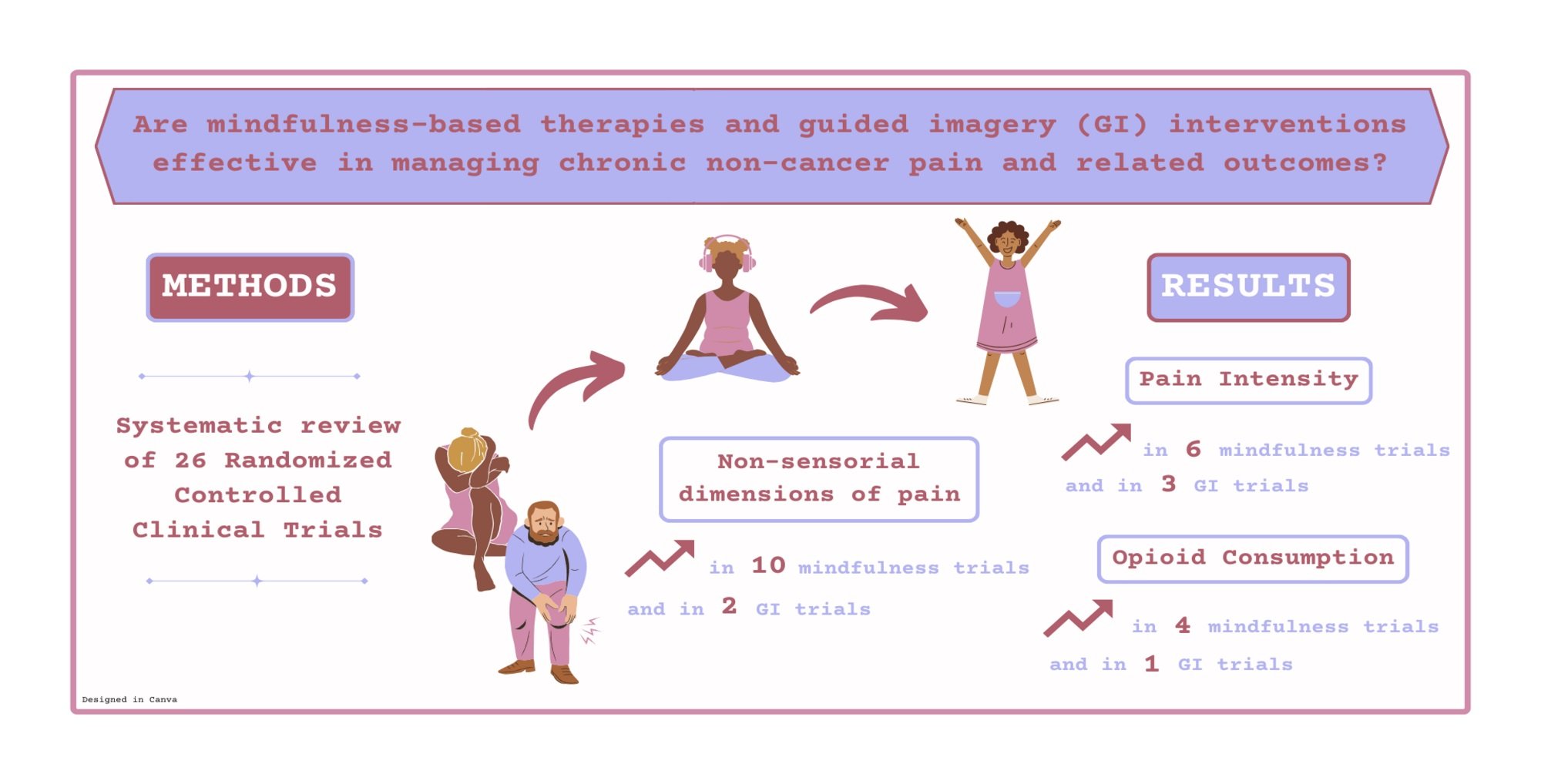
Graphical abstract
Open AccessArticle
Comparative Study of Vitamin D Levels in Newly Diagnosed Tuberculosis and a Normal Population
by
Vasanth Kumar Mamadapur, Shreesha Nagaraju and Mukhyaprana M. Prabhu
Medicina 2024, 60(5), 685; https://0-doi-org.brum.beds.ac.uk/10.3390/medicina60050685 - 23 Apr 2024
Abstract
Background and Objectives: Tuberculosis (TB) is an ancient disease caused by Mycobacterium tuberculosis, a member of the Mycobacterium tuberculosis complex. It contributes to significant morbidity and mortality. Treatment of TB poses a considerable challenge because of emerging drug resistance and the
[...] Read more.
Background and Objectives: Tuberculosis (TB) is an ancient disease caused by Mycobacterium tuberculosis, a member of the Mycobacterium tuberculosis complex. It contributes to significant morbidity and mortality. Treatment of TB poses a considerable challenge because of emerging drug resistance and the longer duration of therapy. Various past studies, both in vitro and in vivo, have established the role of vitamin D in the pathogenesis and treatment of TB. Results of in vivo studies are inconsistent, and this study aims to determine vitamin D levels and their association with newly diagnosed TB (pulmonary and extrapulmonary) cases and normal populations. Material and Methods: A Prospective Case-Control study with 116 subjects (58 cases and 58 controls) was conducted over two years. 29 cases of pulmonary TB and 29 cases of extrapulmonary TB constituted 58 cases of TB. Vitamin D levels were measured and compared in both the cases and controls. Data analysis was carried out using SPSS software 22.0. Results: The prevalence of vitamin D deficiency was 68.96% in the cases, while it was 51.72% in the controls. The reported median and quartile of serum vitamin D levels were 14.35 ng/mL (8.65, 25.48) in the TB group and 19.08 ng/mL (13.92, 26.17) in the control group. There was a significant statistical difference between the TB and non-TB populations with a p-value of 0.029 on the Mann–Whitney test. Conclusion: Vitamin D deficiency was more prevalent in individuals with TB than those without TB.
Full article
(This article belongs to the Special Issue Infectious and Tropical Diseases: Symptoms, Diagnosis and Treatment)
►▼
Show Figures
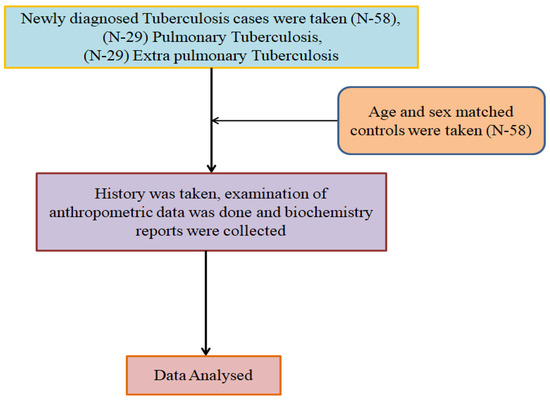
Figure 1
Open AccessArticle
The Effects of Iron Administration on Anemia Development during the 7th and 21st Day of Life in Premature Newborns: A Prospective Cohort Study
by
Oana Cristina Costescu, Aniko Maria Manea, Daniela Mariana Cioboata, Florina Marinela Doandes, Mihaela Zaharie, Mihai Dinu, Daniela Iacob and Marioara Boia
Medicina 2024, 60(5), 684; https://0-doi-org.brum.beds.ac.uk/10.3390/medicina60050684 - 23 Apr 2024
Abstract
Background and Objectives: The administration of iron to premature newborns is a common intervention aimed at preventing iron deficiency (ID). However, there is no consensus on the optimal timing and dosage for iron supplementation in this population. This study evaluates the effects
[...] Read more.
Background and Objectives: The administration of iron to premature newborns is a common intervention aimed at preventing iron deficiency (ID). However, there is no consensus on the optimal timing and dosage for iron supplementation in this population. This study evaluates the effects and potential adverse outcomes of administering iron on the 7th and 21st days of life in premature infants. Materials and Methods: This research was conducted on 108 premature neonates at the “Louis Turcanu” Children’s Emergency Clinical Hospital in Timisoara, Romania. The study population was divided into a control group of 48 newborns who did not receive iron supplementation and an intervention group of 60 newborns who did. The analysis utilized univariate and multivariate regression to examine binary outcomes. Results: The findings indicate that iron supplementation significantly increased the risk of anemia during the premature period at 21 days of life, as demonstrated by both univariate and multivariate regression analyses, with an odds ratio (OR) of 2.40 (95% CI, 1.01–5.68) and an adjusted odds ratio (AOR) of 2.75 (95% CI, 1.06–7.11), respectively. Contrary to expectations, iron supplementation did not significantly alter the risk of abnormal serum ferritin or iron levels at 21 days of life, according to the univariate analysis (p = 0.380 and p = 0.526, respectively). Conclusions: The observed increase in the risk of anemia without a corresponding improvement in the serum ferritin or iron levels suggests the need for further investigation into alternative strategies for iron supplementation in premature newborns.
Full article
(This article belongs to the Topic Public Health and Healthcare in the Context of Big Data)
►▼
Show Figures
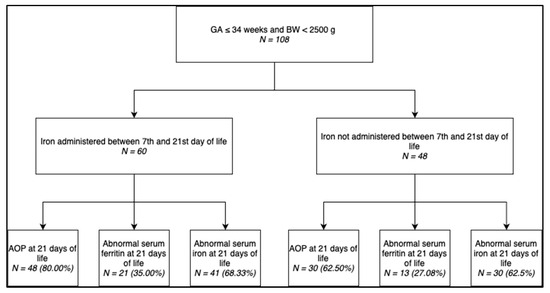
Figure 1
Open AccessReview
Approaches to Medical Emergencies on Commercial Flights
by
Gopi Battineni, Antonio Arcese, Nalini Chintalapudi, Marzio Di Canio, Fabio Sibilio and Francesco Amenta
Medicina 2024, 60(5), 683; https://0-doi-org.brum.beds.ac.uk/10.3390/medicina60050683 - 23 Apr 2024
Abstract
In-flight medical incidents are becoming increasingly critical as passengers with diverse health profiles increase in the skies. In this paper, we reviewed how airlines, aviation authorities, and healthcare professionals respond to such emergencies. The analysis was focused on the strategies developed by the
[...] Read more.
In-flight medical incidents are becoming increasingly critical as passengers with diverse health profiles increase in the skies. In this paper, we reviewed how airlines, aviation authorities, and healthcare professionals respond to such emergencies. The analysis was focused on the strategies developed by the top ten airlines in the world by examining training in basic first aid, collaboration with ground-based medical support, and use of onboard medical equipment. Appropriate training of crew members, availability of adequate medical resources on board airplanes, and improved capabilities of dialogue between a flying plane and medical doctors on the ground will contribute to a positive outcome of the majority of medical issues on board airlines. In this respect, the adoption of advanced telemedicine solutions and the improvement of real-time teleconsultations between aircraft and ground-based professionals can represent the future of aviation medicine, offering more safety and peace of mind to passengers in case of medical problems during a flight.
Full article
(This article belongs to the Section Emergency Medicine)
Open AccessArticle
Retrospective Evaluation of the Effect of Lumbar Sympathetic Blockade on Pain Scores, Fontaine Classification, and Collateral Perfusion Status in Patients with Lower Extremity Peripheral Arterial Disease
by
Celalet Keser-Pehlivan, Cagatay Kucukbingoz, Umur Anil Pehlivan, Huseyin Tugsan Balli, Hakki Unlugenc and Hayri Tevfik Ozbek
Medicina 2024, 60(5), 682; https://0-doi-org.brum.beds.ac.uk/10.3390/medicina60050682 - 23 Apr 2024
Abstract
Background and Objectives: The aim of this retrospective study was to evaluate the effect of lumbar sympathetic block (LSB) on pain scores, Fontaine Classification, and collateral perfusion status in patients with lower extremity peripheral artery disease (PAD), in whom revascularization is impossible.
[...] Read more.
Background and Objectives: The aim of this retrospective study was to evaluate the effect of lumbar sympathetic block (LSB) on pain scores, Fontaine Classification, and collateral perfusion status in patients with lower extremity peripheral artery disease (PAD), in whom revascularization is impossible. Material and Methods: Medical records of 21 patients with PAD who underwent LSB with a combination of local anesthetics, steroids, and patient follow-up forms containing six-month follow-ups between January 2020 and March 2021 were retrospectively reviewed. Numeric Rating Scale (NRS), Pain Detect Questionnaire (PDQ) scores, Fontaine Classification Stages, and collateral perfusion status (collateral diameter and/or development of neovascularization) evaluated by arterial color Doppler Ultrasound (US) from the medical records and follow-up forms of the patients were reviewed. Results: NRS and PDQ scores were significantly lower, and regression of the Fontaine Classification Stages was significantly better after the procedure at the first, third, and sixth month than at the baseline values (p < 0.001). Only four patients (19%) had collaterals before the procedure. An increase in the collateral diameter after LSB was noted in three out of four patients. Before the procedure, 17 patients had no prominent collateral. However, in thirteen of these patients, after LSB, neovascularization was detected during the six-month follow-up period (three patients in the first month, seven patients in the third month, and thirteen patients in the sixth month). The number of patients evolving neovascularization after LSB was found to be statistically significant at the third and sixth months compared to the initial examination (p < 0.001). Conclusions: LSB with the use of local anesthetic and steroids in patients with lower extremity PAD not only led to lower NRS and PDQ scores, but also resulted in regressed Fontaine Classification Stages and better collateral perfusion status.
Full article
(This article belongs to the Section Hematology and Immunology)
►▼
Show Figures
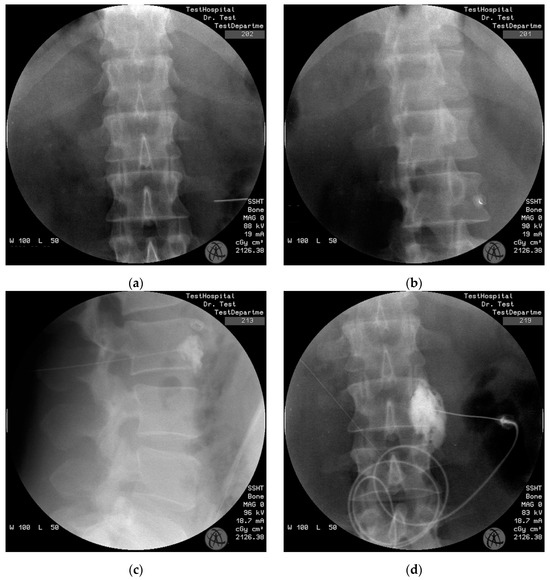
Figure 1
Open AccessArticle
Clinical Anatomy of the Ligaments of the Face and Their Fundamental Distinguishing Features
by
Artem Mirontsev, Olesya Andruschenko, Yuriy Vasil’ev, Elena Verbo, Liyana Kolesova, Ekaterina Blinova, Kirill Zhandarov, Mikhail Nelipa, Petr Panushkin, Ellina Velichko, Yulianna Enina, Zurab Bagatelia and Sergey Dydykin
Medicina 2024, 60(5), 681; https://0-doi-org.brum.beds.ac.uk/10.3390/medicina60050681 - 23 Apr 2024
Abstract
Our study aimed to clarify the anatomical features of the zygomatic, upper masseteric, lower masseteric and mandibular ligaments and their possible contribution to age-related gravitational ptosis. The study was carried out by the method of layered dissection of fresh cadavers. In several observations,
[...] Read more.
Our study aimed to clarify the anatomical features of the zygomatic, upper masseteric, lower masseteric and mandibular ligaments and their possible contribution to age-related gravitational ptosis. The study was carried out by the method of layered dissection of fresh cadavers. In several observations, the zygomatic ligament is represented by the fibers originating from the zygomaticus major muscle fibers. It is a true ligament with the fibers inserted directly into the skin. The upper and lower masseteric ligaments originate from the parotideomasseteric fascia and weave into the thickness of the SMAS. The mandibular ligament consists of two connective tissue laminae originating from the parotideomasseteric fascia at the lower edge of the mandible and from the inner surface of this fascia, along the anterior edge of the masseter muscle, skirting the facial vein sheath and the facial artery, traveling toward the platysma and the depressor anguli oris muscle, and merging with their fibers. The zygomatic ligament should be considered an osteo-musculocutaneous ligament, emphasizing the role of the associated zygomaticus major muscle in the mechanism of aging. The upper and lower masseteric and mandibular ligaments are false fascio-SMAS ligaments rather than osteo-cutaneous ones, playing the barrier role and fixing the superficial fascia and the platysma muscle.
Full article
(This article belongs to the Special Issue Anatomy Education in Clinical Practice: Past, Present and Future)
►▼
Show Figures
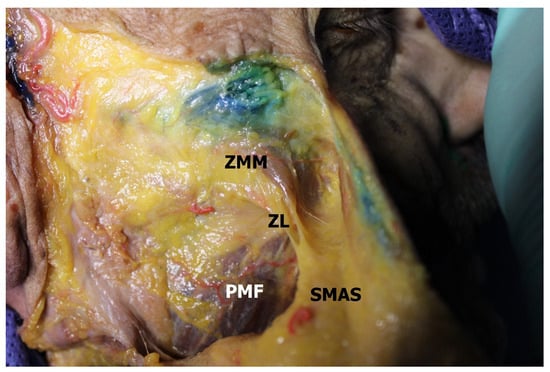
Figure 1
Open AccessArticle
Comparison of the Surgical Outcome between the Multiple Screw Fixation and Fixed Angle Devices for the Basicervical Femoral Neck Fractures
by
Jin-Woo Kim, Jung-Wee Park, Hyo-Jung Kim, Tae-Young Kim, Jun-Il Yoo, Young-Kyun Lee and Byung-Woong Jang
Medicina 2024, 60(5), 680; https://0-doi-org.brum.beds.ac.uk/10.3390/medicina60050680 - 23 Apr 2024
Abstract
Introduction: Basicervical femoral neck fracture (FNF) is an uncommon type of femoral neck fracture and is associated with an increased risk of fixation failure due to its inherent instability. The purpose of this study was to compare the surgical parameters and reoperation
[...] Read more.
Introduction: Basicervical femoral neck fracture (FNF) is an uncommon type of femoral neck fracture and is associated with an increased risk of fixation failure due to its inherent instability. The purpose of this study was to compare the surgical parameters and reoperation rate between the use of a multiple cannulated screw (MCS) and fixed angle device (FAD) in treating basicervical FNFs. Methods: We retrospectively reviewed the records of 885 patients who underwent internal fixation between May 2004 and August 2019 to determine basicervical FNF with at least 12 months of follow-up. Among the identified 77 patients with basicervical FNF, 17 patients who underwent multiple cannulated screw (MCS) fixation and 36 patients who underwent fixed angle device (FAD) fixation were included. We compared the rates of fracture-site collapse and reoperations according to the fixation device. Results: Among the 53 patients with basicervical FNF, 13 patients (24.5%) sustained surgical complications (8 collapses of fracture site and 5 reoperations). The reoperation rate in the MCS group was significantly higher than that in the FAD group (23.5% vs. 2.8%, p = 0.016), without any significant difference in the collapse of the fracture site (11.8% vs. 16.7%, p = 0.642). Conclusions: Although basicervical FNF was rare among hip fractures, fracture site collapse was prevalent and prone to fixation failure. Surgeons should keep this in mind, and consider FAD for basicervical FNF.
Full article
(This article belongs to the Special Issue Clinical Care and Updates on Hip Fractures)
►▼
Show Figures
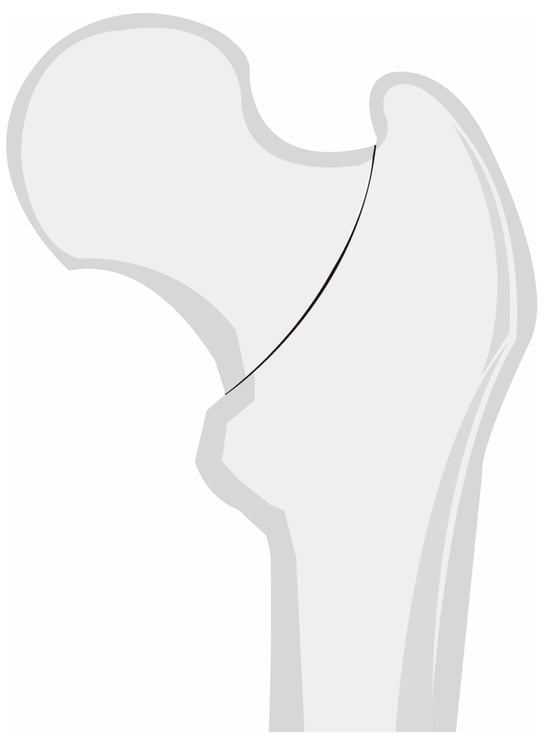
Figure 1
Open AccessArticle
The Effect of Preprocedural Low-Dose Ketamine for Pain and Anxiety in Patients during Thoracic Epidural Catheterization
by
Onur Küçük, Esra Sarı, Musa Zengin, Gülay Ülger, Fatma Öztürk Yalçın, Ramazan Baldemir, Mehtap Tunç and Ali Alagöz
Medicina 2024, 60(4), 679; https://0-doi-org.brum.beds.ac.uk/10.3390/medicina60040679 - 22 Apr 2024
Abstract
Background and Objectives: Thoracic epidural catheterization (TEC) can be both uncomfortable and fearful for patients when performed awake with the thought that the procedure may be painful. The aim of this study was to assess the effect of low-dose intravenous ketamine administration
[...] Read more.
Background and Objectives: Thoracic epidural catheterization (TEC) can be both uncomfortable and fearful for patients when performed awake with the thought that the procedure may be painful. The aim of this study was to assess the effect of low-dose intravenous ketamine administration on pain and anxiety during the TEC procedure. Materials and Methods: Sixty patients were randomly divided into two groups to receive intravenous (IV) placebo (Group P) and IV low-dose (0.15 mg/kg) ketamine (LDK) (Group K) 3 min before the procedure in a double-blind manner. A visual analog scale (VAS) was used to measure anxiety (VAS-A) and pain (VAS-P) scores. Vital parameters were monitored before premedication (T1), 20 min after premedication (T2), during skin anesthesia (T3), during TEC (T4), and 5 min after TEC (T5). VAS-A values were recorded at T1, T3, T4, and T5 periods, and VAS-P levels were noted at T3, T4, and T5 periods. Results: During TEC (T4), both VAS-P and VAS-A were significantly lower in Group K (p < 0.001). The mean VAS-A value was 10.6 mm lower, and the mean VAS-P value was 9 mm lower in Group K than in Group P at the T4 time point. Additionally, the mean VAS-P value was 7.7 mm lower in Group K compared to Group P at the T3 time point (p < 0.001). Both groups showed a statistically significant difference in VAS-A measurements when compared at their respective time points (p < 0.001). However, only Group P demonstrated a statistically significant difference in VAS-P measurements (p < 0.001). VAS-P values remained stable in Group K. The number of patients who did not recall the procedure was significantly higher in Group K (p < 0.001). Furthermore, the number of patients who would consent to the same procedure in the future was significantly higher in Group K (p = 0.007). Conclusions: A preprocedural LDK (0.15 mg/kg) can effectively prevent anxiety and pain experienced by patients during the TEC procedure. Administration of LDK may provide a more comfortable procedure process without causing ketamine-induced side effects (hemodynamic, respiratory, and psychological).
Full article
(This article belongs to the Section Intensive Care/ Anesthesiology)
►▼
Show Figures
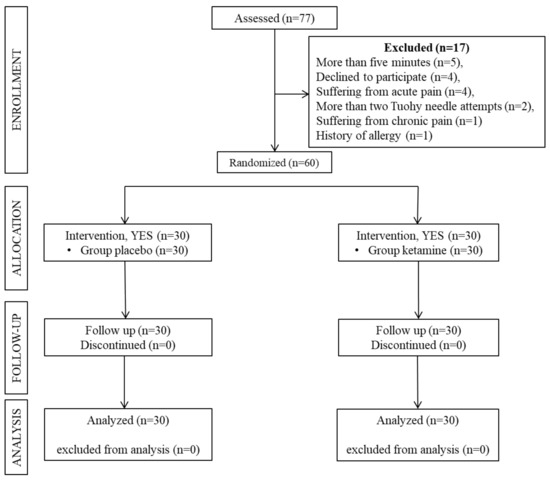
Figure 1
Open AccessReview
Biodegradable Microspheres for Transarterial Chemoembolization in Malignant Liver Disease
by
Ornella Moschovaki-Zeiger, Nikolaos-Achilleas Arkoudis, Athanasios Giannakis, Stavros Grigoriadis, Fotis Anagnostopoulos and Stavros Spiliopoulos
Medicina 2024, 60(4), 678; https://0-doi-org.brum.beds.ac.uk/10.3390/medicina60040678 - 22 Apr 2024
Abstract
Transarterial chemoembolization (TACE) has revolutionized the treatment landscape for malignant liver disease, offering localized therapy with reduced systemic toxicity. This manuscript delves into the use of degradable microspheres (DMS) in TACE, exploring its potential advantages and clinical applications. DMS-TACE emerges as a promising
[...] Read more.
Transarterial chemoembolization (TACE) has revolutionized the treatment landscape for malignant liver disease, offering localized therapy with reduced systemic toxicity. This manuscript delves into the use of degradable microspheres (DMS) in TACE, exploring its potential advantages and clinical applications. DMS-TACE emerges as a promising strategy, offering temporary vessel occlusion and optimized drug delivery. The manuscript reviews the existing literature on DMS-TACE, emphasizing its tolerability, toxicity, and efficacy. Notably, DMS-TACE demonstrates versatility in patient selection, being suitable for both intermediate and advanced stages. The unique properties of DMS provide advantages over traditional embolic agents. The manuscript discusses the DMS-TACE procedure, adverse events, and tumor response rates in HCC, ICC, and metastases.
Full article
(This article belongs to the Collection Interventional Oncology)
►▼
Show Figures
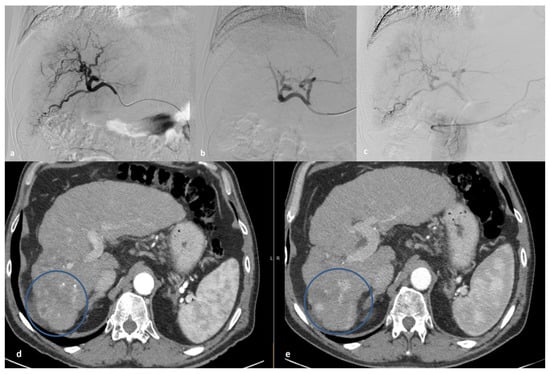
Figure 1
Open AccessArticle
Association between Antenatal Vaginal Bleeding and Adverse Perinatal Outcomes in Placenta Accreta Spectrum
by
J. Connor Mulhall, Kayla E. Ireland, John J. Byrne, Patrick S. Ramsey, Georgia A. McCann and Jessian L. Munoz
Medicina 2024, 60(4), 677; https://0-doi-org.brum.beds.ac.uk/10.3390/medicina60040677 - 22 Apr 2024
Abstract
Background and Objectives: Placenta accreta spectrum (PAS) disorders are placental conditions associated with significant maternal morbidity and mortality. While antenatal vaginal bleeding in the setting of PAS is common, the implications of this on overall outcomes remain unknown. Our primary objective was
[...] Read more.
Background and Objectives: Placenta accreta spectrum (PAS) disorders are placental conditions associated with significant maternal morbidity and mortality. While antenatal vaginal bleeding in the setting of PAS is common, the implications of this on overall outcomes remain unknown. Our primary objective was to identify the implications of antenatal vaginal bleeding in the setting of suspected PAS on both maternal and fetal outcomes. Materials and Methods: We performed a case-control study of patients referred to our PAS center of excellence delivered by cesarean hysterectomy from 2012 to 2022. Subsequently, antenatal vaginal bleeding episodes were quantified, and components of maternal morbidity were assessed. A maternal composite of surgical morbidity was utilized, comprised of blood loss ≥ 2 L, transfusion ≥ 4 units of blood, intensive care unit (ICU) admission, and post-operative length of stay ≥ 4 days. Results: During the time period, 135 cases of confirmed PAS were managed by cesarean hysterectomy. A total of 61/135 (45.2%) had at least one episode of bleeding antenatally, and 36 (59%) of these had two or more bleeding episodes. Increasing episodes of antenatal vaginal bleeding were associated with emergent delivery (p < 0.01), delivery at an earlier gestational age (35 vs. 34 vs. 33 weeks, p < 0.01), and increased composite maternal morbidity (76, 84, and 94%, p = 0.03). Conclusions: Antenatal vaginal bleeding in the setting of PAS is associated with increased emergent deliveries, earlier gestational ages, and maternal composite morbidity. This important antenatal event may aid in not only counseling patients but also in the coordination of multidisciplinary teams caring for these complex patients.
Full article
(This article belongs to the Section Obstetrics and Gynecology)
►▼
Show Figures
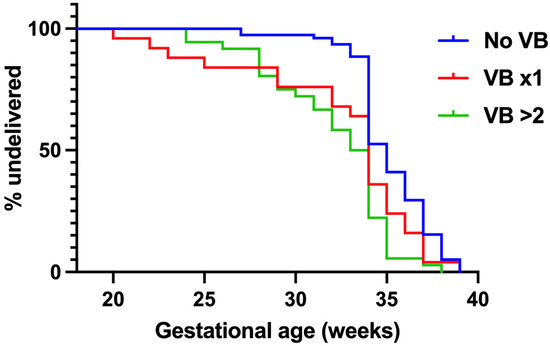
Figure 1
Open AccessArticle
Intrahepatic Cholestasis of Pregnancy during COVID-19 Pandemic
by
Paulina Malarkiewicz, Urszula Nowacka, Aleksandra Januszaniec, Alicja Mankiewicz, Szymon Kozłowski and Tadeusz Issat
Medicina 2024, 60(4), 676; https://0-doi-org.brum.beds.ac.uk/10.3390/medicina60040676 - 22 Apr 2024
Abstract
Background and Objectives: Intrahepatic cholestasis of pregnancy (ICP) stands as one of the most prevalent concerns in maternal–fetal medicine, presenting a significant risk to fetal health and often associated with liver dysfunction. Concurrently, the coronavirus-19 (COVID-19) infection can lead to hepatic cell
[...] Read more.
Background and Objectives: Intrahepatic cholestasis of pregnancy (ICP) stands as one of the most prevalent concerns in maternal–fetal medicine, presenting a significant risk to fetal health and often associated with liver dysfunction. Concurrently, the coronavirus-19 (COVID-19) infection can lead to hepatic cell injury through both direct and indirect pathways. Hypothetically, these two conditions may coincide, influencing each other. This study aimed to comparatively assess the incidence and severity of ICP before and during the COVID-19 pandemic. Methods: A retrospective cohort study was conducted, comparing the incidence and severity of ICP between January 2018 and February 2020 (pre-COVID-19 period) and March 2020 to March 2022 (COVID-19 period) across two hospitals, encompassing 7799 deliveries. The diagnosis of ICP was established using the ICD-10 code and defined as total bile acids (BA) levels ≥ 10 μmol/L. Statistical analysis included descriptive statistics, Chi-square and Mann–Whitney U tests, as well as multiple or logistic regression analysis. Results: A total of 226 cases of ICP were identified. The incidence of mild cholestasis (BA < 40 μmol/L) was lower during the pandemic compared to before (3% before versus 2%, p < 0.05), while the incidence of moderate and severe ICP remained unchanged (0.6% before vs. 0.4%, p = 0.2). Overall, the total incidence of ICP was lower during the pandemic (3.6% before versus 2.4%, p = 0.01). No significant differences were observed in severity (as defined by BA and liver function test levels), rates of caesarean section, or neonatal birth weights. Conclusions: During the COVID-19 pandemic, the total incidence of ICP appeared to be lower. However, this reduction was primarily observed in cases of mild ICP, potentially indicating challenges in detection or reduced access to medical services during this period. The incidence of moderate and severe ICP remained unchanged, suggesting that these forms of the condition were unaffected by the pandemic’s circumstances.
Full article
(This article belongs to the Special Issue Diagnosis, Evaluation, and Management of Diseases during Pregnancy: Part II)
Open AccessArticle
Shift from Pro- to Anti-Inflammatory Phase in Pelvic Floor Muscles at Postpartum Matches Histological Signs of Regeneration in Multiparous Rabbits
by
Esteban Rodríguez-Benítez, Kenia López-García, Nicte Xelhuantzi, Dora Luz Corona-Quintanilla, Francisco Castelán and Margarita Martínez-Gómez
Medicina 2024, 60(4), 675; https://0-doi-org.brum.beds.ac.uk/10.3390/medicina60040675 - 21 Apr 2024
Abstract
Background and Objectives: Pelvic floor muscles (PFM) play a core role in defecation and micturition. Weakening of PFM underlies urogynecological disorders such as pelvic organ prolapse and stress urinary incontinence. Vaginal delivery damages PFM. Muscle trauma implies an inflammatory response mediated by
[...] Read more.
Background and Objectives: Pelvic floor muscles (PFM) play a core role in defecation and micturition. Weakening of PFM underlies urogynecological disorders such as pelvic organ prolapse and stress urinary incontinence. Vaginal delivery damages PFM. Muscle trauma implies an inflammatory response mediated by myeloid cells, essential for subsequent recovery. Molecular signaling characterizing the pro-inflammatory phase shifts M1 macrophages to M2 macrophages, which modulate muscle repair. The present study aimed to evaluate histological characteristics and the presence of M1 and M2 macrophages in bulbospongiosus (Bsm) and pubococcygeus muscles (Pcm). Materials and Methods: Muscles from young nulliparous (N) and multiparous rabbits on postpartum days three (M3) and twenty (M20) were excised and histologically processed to measure the myofiber cross-sectional area (CSA) and count the centralized myonuclei in hematoxylin-eosinstained sections. Using immunohistochemistry, M1 and M2 macrophages were estimated in muscle sections. Kruskal–Wallis or one-way ANOVA testing, followed by post hoc tests, were conducted to identify significant differences (p < 0.05). Results: The myofiber CSA of both the Bsm and Pcm of the M3 group were more extensive than those of the N and M20 groups. Centralized myonuclei estimated in sections from both muscles of M20 rabbits were higher than those of N rabbits. Such histological outcomes matched significant increases in HLA-DR immunostaining in M3 rabbits with the CD206 immunostaining in muscle sections from M20 rabbits. Conclusions: A shift from the pro- to anti-inflammatory phase in the bulbospongiosus and pubococcygeus muscles of multiparous rabbits matches with centralized myonuclei, suggesting the ongoing regeneration of muscles.
Full article
(This article belongs to the Section Urology & Nephrology)
►▼
Show Figures
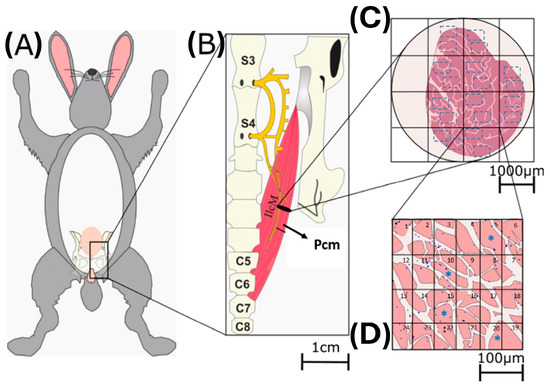
Figure 1
Open AccessArticle
Do Subjects from Different Occupational Groups Experience Dental Fear and Anxiety Equally?
by
Eglė Slabšinskienė, Karolina Radlinskaitė, Aistė Kavaliauskienė, Ingrida Vasiliauskienė, Jūratė Zūbienė, Kristina Saldūnaitė-Mikučionienė and Apolinaras Zaborskis
Medicina 2024, 60(4), 674; https://doi.org/10.3390/medicina60040674 - 21 Apr 2024
Abstract
Background and Objectives: Research into the relationship between occupation and dental fear and anxiety (DFA) is scarce. This exploratory study aimed to compare the level of DFA and its association with its predictors amongst adults from different occupational groups. Materials and Methods: A
[...] Read more.
Background and Objectives: Research into the relationship between occupation and dental fear and anxiety (DFA) is scarce. This exploratory study aimed to compare the level of DFA and its association with its predictors amongst adults from different occupational groups. Materials and Methods: A cross-sectional study with 422 respondents from four occupational groups (physicians, teachers, industry workers, and artists) was carried out. A questionnaire on previous dental experience using the Dental Anxiety Scale (DAS), Dental Fear Survey (DFS), and Self-Esteem Scale was self-administered electronically. The data analysis involved descriptive statistics and structural equation modeling (SEM). Results: The DFA levels differed significantly across the occupational groups, with the lowest mean scores among physicians (DAS = 9.29 (SE 0.39); DFS-1 = 14.67 (0.63); DFS-2 = 33.94 (1.69)) and the highest mean scores among artists (DAS = 10.74 (0.38); DFS-1 = 17.19 (0.71); DFS-2 = 41.34 (1.92)). A significant impact of self-esteem on DFA was observed among physicians, teachers, and artists, but not among industry workers. Multi-group analysis with SEM revealed differences in the variable association (Chi-squared = 53.75; df = 21; p < 0.001), thus rejecting the hypothesis of the same mechanism underlying DFA across occupational groups. Conclusions: Individuals from various occupations experience DFA at different levels, and there are different mechanisms underlying their DFA. These findings can provide valuable insights for dental practitioners in developing tailored approaches to reduce the feeling of DFA of their patients.
Full article
(This article belongs to the Section Dentistry)
►▼
Show Figures
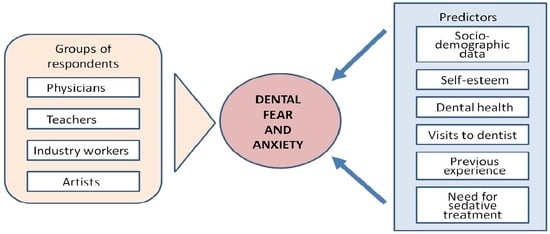
Graphical abstract
Open AccessArticle
National Trends in the Incidence of Sporadic Malignant Colorectal Polyps in Young Patients (20–49 Years): An 18-Year SEER Database Analysis
by
Mark M. Aloysius, Tejas Nikumbh, Lekha Yadukumar, Udit Asija, Niraj J. Shah, Ganesh Aswath, Savio John and Hemant Goyal
Medicina 2024, 60(4), 673; https://doi.org/10.3390/medicina60040673 - 21 Apr 2024
Abstract
Background and Objectives: Conflicting guidelines exist for initiating average-risk colorectal cancer screening at the age of 45 years. The United States Preventive Services Task Force (USPSTF) changed its guidelines in 2021 to recommend initiating screening at 45 years due to an increasing
[...] Read more.
Background and Objectives: Conflicting guidelines exist for initiating average-risk colorectal cancer screening at the age of 45 years. The United States Preventive Services Task Force (USPSTF) changed its guidelines in 2021 to recommend initiating screening at 45 years due to an increasing incidence of young-onset colorectal cancer. However, the American College of Physicians (ACP) recently recommended not screening average-risk individuals between 45 and 49 years old. We aim to study the national trends in the incidence of sporadic malignant polyps (SMP) in patients from 20 to 49 years old. Materials and Methods: We analyzed the Surveillance, Epidemiology, and End Results database (2000–2017) on patients aged 20–49 years who underwent diagnostic colonoscopy with at least a single malignant sporadic colorectal polyp. Results: Of the 10,742 patients diagnosed with SMP, 42.9% were female. The mean age of incidence was 43.07 years (42.91–43.23, 95% CI). Approximately 50% of malignant polyps were diagnosed between 45 and 49 years of age, followed by 25–30% between 40 and 45. There was an upward trend in malignant polyps, with a decreased incidence of malignant villous adenomas and a rise in malignant adenomas and tubulovillous adenomas. Conclusions: Our findings suggest that almost half of the SMPs under 50 years occurred in individuals under age 45, younger than the current screening threshold recommended by the ACP. There has been an upward trend in malignant polyps in the last two decades. This reflects changes in tumor biology, and necessitates further research and support in the USPSTF guidelines to start screening at the age of 45 years.
Full article
(This article belongs to the Special Issue Editorial Board Members’ Collection Series: Gastrointestinal and Hepatic Diseases)
►▼
Show Figures
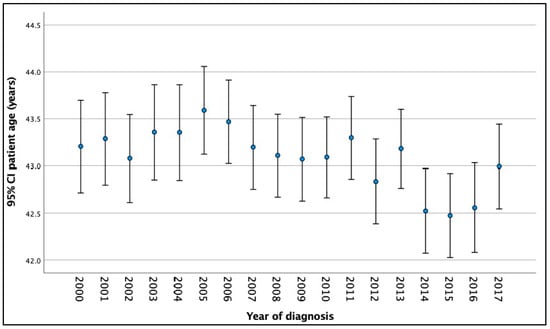
Figure 1
Open AccessReview
Microbiota Transplantation as an Adjunct to Standard Periodontal Treatment in Periodontal Disease: A Systematic Review
by
Cherry Erlin Lindo, James Sebastian, Karina Natalie Kuntjoro, Valencia Audrey Halim, Fatimah Maria Tadjoedin, Sandra Olivia Kuswandani and Benso Sulijaya
Medicina 2024, 60(4), 672; https://0-doi-org.brum.beds.ac.uk/10.3390/medicina60040672 - 21 Apr 2024
Abstract
Periodontitis is a disease linked to severe dysbiosis of the subgingival microbiome. The treatment of periodontitis aims to change the dysbiosis environment to a symbiosis environment. We hypothesized that oral microbiota transplantation can lead to a significant improvement in periodontitis. Therefore, the aim
[...] Read more.
Periodontitis is a disease linked to severe dysbiosis of the subgingival microbiome. The treatment of periodontitis aims to change the dysbiosis environment to a symbiosis environment. We hypothesized that oral microbiota transplantation can lead to a significant improvement in periodontitis. Therefore, the aim of this study was to determine the effectiveness of microbiota transplantation after standard periodontal treatment in periodontitis patients. The search strategy was carried out by using the Boolean term “AND” to combine the keywords, which were “periodontitis AND microbiota transplantation”. Due to the limited resources of the study, we included both in vitro and in vivo investigations in this systematic review. The QUIN risk of bias tool was employed to assess the risk of bias in in vitro studies, while SYRCLE’s risk of bias assessment was used for in vivo studies. Oral microbiota transplants (OMTs) have shown potential in treating periodontitis. OMTs significantly reduced periodontitis-associated pathogenic microbial species (P. endodontalis, Prevotella intermedia, T. vincentii, Porphyromonas sp.) and increased beneficial bacteria (P. melaninogenica, Fusobacterium nucleatum, P. catoniae, Capnocytophaga ochracea, C. sputigena, C. gingivalis, Haemophilus parainfluenzae, and Neisseria elongata) upon in vitro testing. Furthermore, in the in vivo tests, single adjunctive OMT also had an effect on the oral microbiota composition compared to the full-mouth mechanical and antimicrobial debridement. OMTs may be cheaper and more effective at addressing high-risk individuals. At present, it is not possible to provide OMT clinical advice due to the lack of available information. This treatment needs to be subjected to more safety and efficacy testing before being included human clinical trials.
Full article
(This article belongs to the Section Dentistry)
►▼
Show Figures
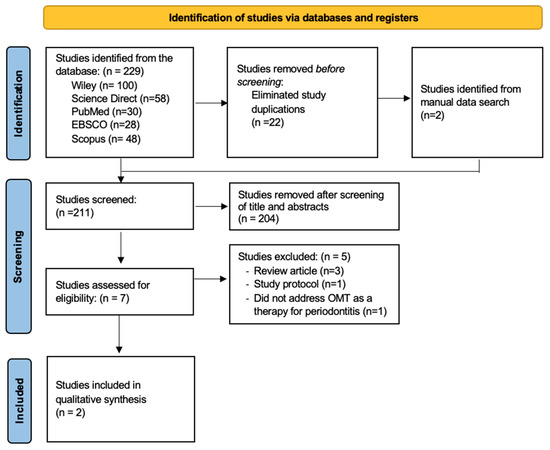
Figure 1
Open AccessArticle
The Effects of Six Weeks Pulmonary Rehabilitation on Functional and Psychological Outcomes in Long-COVID Patients: Preliminary Results from Serbian Single Center Study
by
Natasa Mujovic, Dejan Nikolic, Filip Markovic, Mihailo Stjepanovic, Milica Zekovic, Hussain Saleh H. Ali, Dubravka Zivanovic, Milan Savic and Marija Laban
Medicina 2024, 60(4), 671; https://0-doi-org.brum.beds.ac.uk/10.3390/medicina60040671 - 21 Apr 2024
Abstract
Background and Objectives: In this study, we aimed to evaluate the effects of six weeks of pulmonary rehabilitation on functional and psychological outcomes in long-COVID patients. Material and Methods: The prospective clinical study included 46 patients that were diagnosed with COVID-19. A respiratory
[...] Read more.
Background and Objectives: In this study, we aimed to evaluate the effects of six weeks of pulmonary rehabilitation on functional and psychological outcomes in long-COVID patients. Material and Methods: The prospective clinical study included 46 patients that were diagnosed with COVID-19. A respiratory rehabilitation program was implemented for six weeks. Further valuables were tested before the beginning of the rehabilitation program (admission) and six weeks after (discharge): SpO2, heart rate, respiratory rate, Visual Analogue Scale (VAS) score, Borg score, Sit-to-Stand (StS) test number of repetition, distance of 6-Minute Walking Test (6MWT), Patient Health Questionnaire (PHQ) 9 score and Generalized anxiety disorder (GAD) anxiety score. These parameters were tested before the rehabilitation program on admission and at discharge and after the rehabilitation program on admission and at discharge. The results were presented with standard descriptive and analytical methods. Differences between the continuous variables before and after physical rehabilitation intervention were tested using the Wilcoxon test. Graphical analysis is presented with a box plot. Results: On discharge, in comparison with admission, the values of SpO2 were significantly lower (p = 0.007) before the 6MWT, and VAS scores were significantly higher (p = 0.036), while after the 6MWT, VAS scores were significantly lower (p < 0.001) as were Borg scores (p = 0.016). On discharge, in comparison with admission, the respiratory rate was significantly higher (p = 0.005) before the StS test, and Borg scores were significantly lower (p = 0.001), while after the StS test, SpO2 levels were significantly higher (p = 0.036) and VAS scores were significantly lower (p < 0.001), as were Borg scores (p = 0.008). After discharge, the values of the StS test were significantly higher (p = 0.011), PHQ9 scores were significantly lower (p < 0.001) and GAD anxiety scores were significantly lower as well (p = 0.005), while the distances measured in meters on the 6MWT were significantly increased (p < 0.001). Conclusions: A structured rehabilitation program in our study was shown to have beneficial effects on physiological, psychological and functional improvements in patients with long-COVID, and therefore it is advisable for these patients.
Full article
(This article belongs to the Section Pulmonary)
►▼
Show Figures
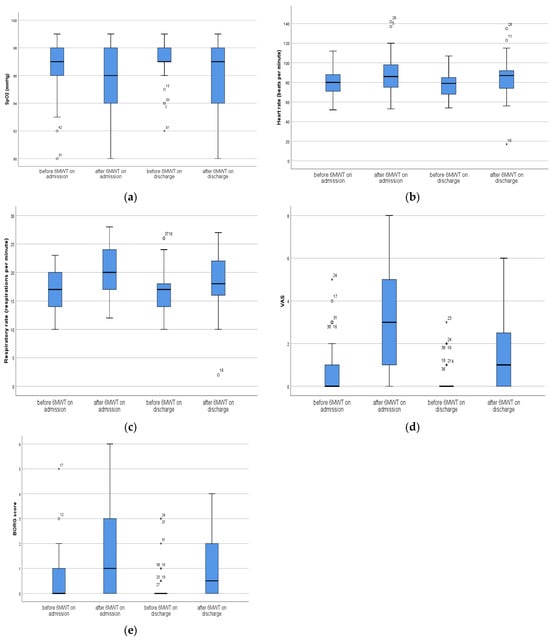
Figure 1
Open AccessArticle
Exosomes and Signaling Nanovesicles from the Nanofiltration of Preconditioned Adipose Tissue with Skin-B® in Tissue Regeneration and Antiaging: A Clinical Study and Case Report
by
Fabiano Svolacchia, Lorenzo Svolacchia, Patrizia Falabella, Carmen Scieuzo, Rosanna Salvia, Fabiana Giglio, Alessia Catalano, Carmela Saturnino, Pierpaolo Di Lascio, Giuseppe Guarro, Giusy Carmen Imbriani, Giuseppe Ferraro and Federica Giuzio
Medicina 2024, 60(4), 670; https://0-doi-org.brum.beds.ac.uk/10.3390/medicina60040670 - 21 Apr 2024
Abstract
Background and Objectives: This three-year clinical trial aimed to demonstrate that only the signaling vesicles produced by ADSCa, containing mRNA, microRNA, growth factors (GFs), and bioactive peptides, provide an advantage over classical therapy with adipose disaggregate to make the tissue regeneration technique
[...] Read more.
Background and Objectives: This three-year clinical trial aimed to demonstrate that only the signaling vesicles produced by ADSCa, containing mRNA, microRNA, growth factors (GFs), and bioactive peptides, provide an advantage over classical therapy with adipose disaggregate to make the tissue regeneration technique safer due to the absence of interfering materials and cells, while being extremely minimally invasive. The infiltration of disaggregated adipose nanofat, defined by the Tonnard method, for the regeneration of the dermis and epidermis during physiological or pathological aging continues to be successfully used for the presence of numerous adult stem cells in suspension (ADSCa). An improvement in this method is the exclusion of fibrous shots and cellular debris from the nanofat to avoid inflammatory phenomena by microfiltration. Materials and Methods: A small amount of adipose tissue was extracted after surface anesthesia and disaggregated according to the Tonnard method. An initial microfiltration at 20/40 microns was performed to remove fibrous shots and cellular debris. The microfiltration was stabilized with a sterile solution containing hyaluronic acid and immediately ultrafiltered to a final size of 0.20 microns to exclude the cellular component and hyaluronic acid chains of different molecular weights. The suspension was then injected into the dermis using a mesotherapy technique with microinjections. Results: This study found that it is possible to extract signaling microvesicles using a simple ultrafiltration system. The Berardesca Scale, Numeric Rating Scale (NRS), and Modified Vancouver Scale (MVS) showed that it is possible to obtain excellent results with this technique. The ultrafiltrate can validly be used in a therapy involving injection into target tissues affected by chronic and photoaging with excellent results. Conclusions: This retrospective clinical evaluation study allowed us to consider the results obtained with this method for the treatment of dermal wrinkles and facial tissue furrows as excellent. The method is safe and an innovative regenerative therapy as a powerful and viable alternative to skin regeneration therapies, antiaging therapies, and chronic inflammatory diseases because it lacks the inflammatory component produced by cellular debris and fibrous sprouts and because it can exclude the mesenchymal cellular component by reducing multiple inflammatory cytokine levels.
Full article
(This article belongs to the Section Translational Medicine)
►▼
Show Figures
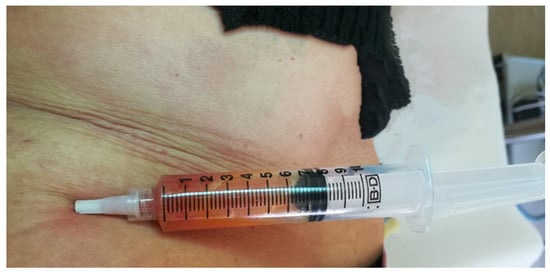
Figure 1
Open AccessArticle
Consumption of Dietary Supplements among Working-Age Residents of Lithuania in the Period from 2021 to 2023
by
Rokas Arlauskas, Donatas Austys, Valerij Dobrovolskij and Rimantas Stukas
Medicina 2024, 60(4), 669; https://0-doi-org.brum.beds.ac.uk/10.3390/medicina60040669 - 19 Apr 2024
Abstract
Background and Objectives: The aim of this study was to assess the consumption of dietary supplements (DS) among working-age residents of Lithuania from 2021 to 2023 with respect to social and demographic factors and an assessment of personal health. Materials and Methods: Using
[...] Read more.
Background and Objectives: The aim of this study was to assess the consumption of dietary supplements (DS) among working-age residents of Lithuania from 2021 to 2023 with respect to social and demographic factors and an assessment of personal health. Materials and Methods: Using stratified sampling techniques, this study included three samples of working-age residents (1600 each year, 4800 total). Three surveys were conducted, the distribution of the respondents between groups was compared using the χ2 test. Results: The consumption of DS significantly differed each year and accounted for 78.1%, 71.6%, and 72.7% of the respondents, respectively (p < 0.05). In 2022, the prevalence of the consumption of DS was lower in the majority of social and demographic groups (p < 0.05). In 2023, it was higher among females, younger residents, and those from larger families, who suffered from COVID-19 (p < 0.05). Despite similar changes found in the consumption of DS among those who negatively assessed their health, this group showed more prevalent consumption of DS among residents with non-university education, unemployed respondents, and those with lower income (p < 0.05). Conclusions: Despite a significantly lower prevalence in the consumption of DS in 2022, it was higher again in 2023. The assessment of personal health shows different habits in the consumption of DS.
Full article
(This article belongs to the Section Epidemiology & Public Health)
Open AccessArticle
Postoperative Morbidity after Dental Treatment under General Anesthesia in Children with and without Disabilities
by
Marija Šimunović-Erpušina, Danko Bakarčić, Odri Cicvarić, Luka Šimunović, Vlatka Sotošek, Dorotea Petrović and Nataša Ivančić Jokić
Medicina 2024, 60(4), 668; https://0-doi-org.brum.beds.ac.uk/10.3390/medicina60040668 - 19 Apr 2024
Abstract
Background and Objectives: General anesthesia induces reversible unconsciousness, eliminating sensation and enabling painless medical procedures. Vital for dental care, it addresses patients with medical conditions, those needing extensive procedures, and those unable to cooperate due to fear. Dental care for patients with disabilities
[...] Read more.
Background and Objectives: General anesthesia induces reversible unconsciousness, eliminating sensation and enabling painless medical procedures. Vital for dental care, it addresses patients with medical conditions, those needing extensive procedures, and those unable to cooperate due to fear. Dental care for patients with disabilities is a significant unmet need, with studies showing increased oral disease prevalence. This research aims to analyze postoperative morbidity both in healthy and disabled children undergoing dental procedures under general anesthesia. Materials and Methods: This study involved 96 children aged 3 to 15 with dental caries. Two groups were formed: the control group (CTL) (52.94%) included healthy patients requiring general anesthesia due to unsatisfactory cooperation, and the other group included children with physical or intellectual disabilities (CD) (47.96%). Postoperative complications were monitored 1 h after the procedure and 1, 3, 7, and 14 days after the procedure by contacting parents/caregivers by phone. The intensity of postoperative pain was assessed using the Wong–Baker faces pain rating scale. General anesthesia was conducted following a standardized protocol for dental procedures. Results: CTL patients complained more often about postoperative pain 1 h after the procedure (p = 0.03). One day after the procedure, oral bleeding (p = 0.04), fever (p = 0.009), and diarrhea (p = 0.037) occurred more often in CD. In the same period, sore throat appeared more often in CTL (p = 0.036). Three days after the dental treatment, there were statistically significant increases in the occurrence of agitation (p = 0.043) and constipation (p = 0.043) in CD. Seven days later, CD demonstrated a higher occurrence of agitation (p = 0.037). According to the Wong–Baker faces pain rating scale, CTL experienced more frequent and intense pain. Conclusions: CD more frequently reported complications like oral bleeding, fever, and diarrhea. In contrast, the CTL group more often reported pain-related symptoms. The conclusion underscores the need for a pain control protocol for CD and emphasizes the importance of frequent monitoring to prevent unwanted consequences during tooth restoration under general anesthesia.
Full article
(This article belongs to the Special Issue Recent Advances in Pediatric Oral Health)
►▼
Show Figures
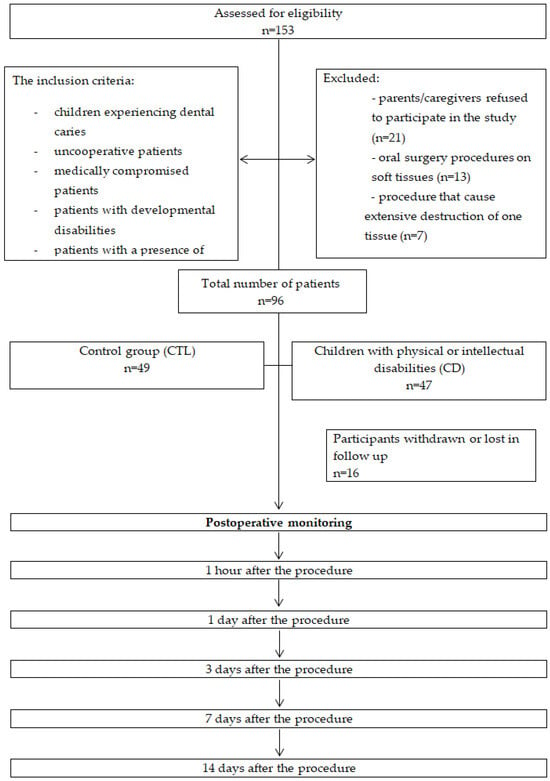
Figure 1

Journal Menu
► ▼ Journal Menu-
- Medicina Home
- Aims & Scope
- Editorial Board
- Reviewer Board
- Topical Advisory Panel
- Instructions for Authors
- Special Issues
- Topics
- Sections & Collections
- Article Processing Charge
- Indexing & Archiving
- Editor’s Choice Articles
- Most Cited & Viewed
- Journal Statistics
- Journal History
- Journal Awards
- Society Collaborations
- Conferences
- Editorial Office
Journal Browser
► ▼ Journal BrowserHighly Accessed Articles
Latest Books
E-Mail Alert
News
Topics
Topic in
Anatomia, Biology, Medicina, Pathophysiology, Tomography
Human Anatomy and Pathophysiology, 2nd Volume
Topic Editors: Francesco Cappello, Mugurel Constantin RusuDeadline: 31 May 2024
Topic in
Applied Sciences, Dentistry Journal, JCM, JFB, Medicina
Diagnosis and Treatment of Dental Diseases and Tempromandibular Joints
Topic Editors: Rafał Obuchowicz, Małgorzata Pihut, Karolina Nurzynska, Andrzej UrbanikDeadline: 31 August 2024
Topic in
JCDD, JCM, Medicina, Membranes, ARM
Extracorporeal Membrane Oxygenation (ECMO)
Topic Editors: Patrick Honore, Isabelle MichauxDeadline: 30 November 2024
Topic in
Biomedicines, IJMS, JCM, Medicina, Neurology International
Advances in Exercise-Induced Neurogenesis, Neuronal and Functional Adaptations in Neurorehabilitation
Topic Editors: Carlos Bernal-Utrera, Cleofas Rodriguez-Blanco, Maria Livia Carrascal MorenoDeadline: 22 December 2024

Conferences
Special Issues
Special Issue in
Medicina
Obstructive Sleep Apnea Syndrome: From Diagnose to Treatment
Guest Editor: Athanasia PatakaDeadline: 30 April 2024
Special Issue in
Medicina
Diagnosis and Treatment of Diseases of the Facial Skeleton, Oral Cavity, and Paranasal Sinuses
Guest Editors: Kamil Nelke, Maciej Dobrzyński, Marceli ŁukaszewskiDeadline: 20 May 2024
Special Issue in
Medicina
Updates on Post-mastectomy Breast Reconstruction
Guest Editors: Glenda Giorgia Caputo, Rossella Sgarzani, Pier Camillo ParodiDeadline: 30 May 2024
Special Issue in
Medicina
Current Status and Future Directions of Bone Trauma Surgery
Guest Editors: Ivo Dumić-Čule, Tomislav ČengićDeadline: 15 June 2024
Topical Collections
Topical Collection in
Medicina
Interventional Oncology
Collection Editors: François Cornelis, Matthias Barral, Adrian Kastler, Dimitrios Filippiadis
Topical Collection in
Medicina
Frontiers in Breast Cancer Diagnosis and Treatment
Collection Editors: Jimmy T. Efird, Tithi Biswas
Topical Collection in
Medicina
Interdisciplinary Medicine – The Key For Personalized Medicine
Collection Editor: Camelia Diaconu
Topical Collection in
Medicina
Advances in Cornea, Cataract, and Refractive Surgery
Collection Editor: Ivo Guber




